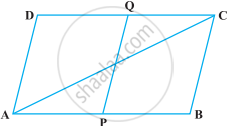Advertisements
Advertisements
Question
A diagonal of a parallelogram bisects one of its angles. Show that it is a rhombus.
Solution
Given: Let ABCD is a parallelogram and diagonal AC bisects the angle A.
∴ ∠CAB = ∠CAD ...(i)
To show: ABCD is a rhombus.
Proof: Since, ABCD is a parallelogram, therefore AB || CD and AC is a transversal.
∴ ∠CAB = ∠ACD ...[Alternate interior angles]
So, ∠ACD = ∠ACB [∵ ∠CAB = ∠CAD, given] ...(ii)
Also, ∠A = ∠C ...[Opposite angles of parallelogram are equal]
⇒ `1/2`∠A = `1/2`∠C ...[Dividing both sides by 2]
⇒ ∠DAC = ∠DCA ...[From equations (i) and (ii)]
⇒ CD = AD ...[Sides opposite to the equal angles are equal]
But AB = CD and AD = BC ...[Opposite sides of parallelogram are equal]
∴ AB = BC = CD = AD
Thus, all sides are equal.
So, ABCD is a rhombus.
Hence proved.
APPEARS IN
RELATED QUESTIONS
Diagonals of a parallelogram `square`WXYZ intersect each other at point O. If ∠XYZ = 135° then what is the measure of ∠XWZ and ∠YZW?
If l(OY)= 5 cm then l(WY)= ?

The diagonals AC and BD of a parallelogram ABCD intersect each other at the point O. If ∠DAC = 32º and ∠AOB = 70º, then ∠DBC is equal to ______.
E and F are points on diagonal AC of a parallelogram ABCD such that AE = CF. Show that BFDE is a parallelogram.
Points P and Q have been taken on opposite sides AB and CD, respectively of a parallelogram ABCD such that AP = CQ (Figure). Show that AC and PQ bisect each other.

In the following figure, AB || DE, AB = DE, AC || DF and AC = DF. Prove that BC || EF and BC = EF.

If the diagonals of a quadrilateral bisect each other, it is a ______.
The point of intersection of diagonals of a quadrilateral divides one diagonal in the ratio 1:2. Can it be a parallelogram? Why or why not?
Two sticks each of length 5 cm are crossing each other such that they bisect each other. What shape is formed by joining their endpoints? Give reason.
Two sticks each of length 7 cm are crossing each other such that they bisect each other at right angles. What shape is formed by joining their end points? Give reason.
